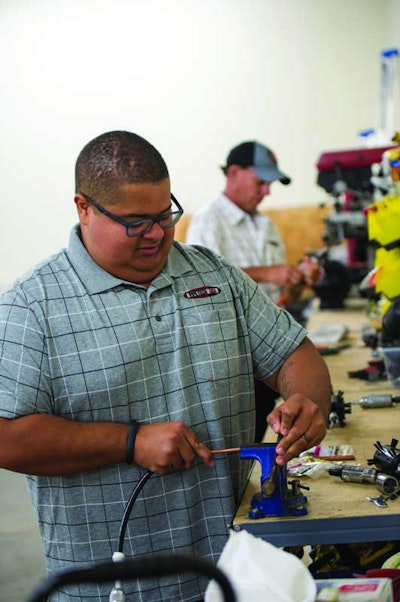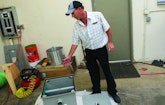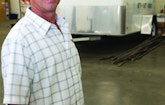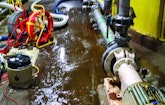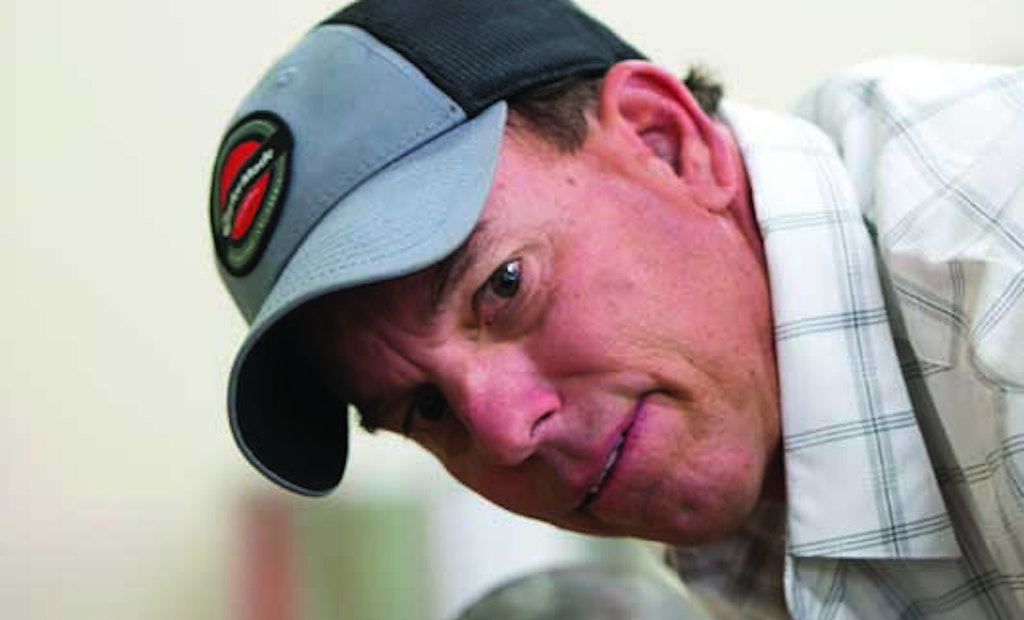Interested in Relining/Rehab?
Get Relining/Rehab articles, news and videos right in your inbox! Sign up now.
Relining/Rehab + Get AlertsTom Richards doesn’t worry much about pricing strategy. The clients he works for don’t mind paying whatever is necessary to get the job done.
“They don’t question the cost,” Richards says. “All they want to know is if I can do the job and when can I do it. They only care about getting the problem fixed and not having to shut down to do it, because shutting down for just an hour could mean losing a lot of money — more than it will cost me to get the job done.”
In 2014, Richards developed his own robotic unit capable of spray-coating pipe with a polyurea that is quick to cure, highly chemical-resistant and NSF61-approved for potable water.
This current specialization has been a decades-long progression for Richards, who first started in the plumbing trade 40 years ago. Since forming his own Sacramento, California-based business, now known as Pipe Tech USA, he has continuously looked for new and better ways to solve customers’ problems, and that approach has led to profitability.
“I haven’t done regular plumbing work in about 20 years, and I haven’t done any pipe lining in the last couple years because I’m so swamped with the coating,” Richards says. “Nobody else does it. That’s the whole idea — to have a niche your competitor doesn’t have.”
One step to the next
Richards started his career as a plumber, working for another contractor in the Sacramento area doing standard repair work and new installations. By 1989, he had his own shop,
Richards & Son’s Plumbing, and grew the business steadily, making adjustments in his service offerings along the way. When residential construction dropped off, he started focusing more on commercial work. It was while doing commercial jobs that Richards first noticed his next opportunity.
“I was doing a lot of work for restaurants and replacing grease traps because grease can be very acidic,” Richards says. “Sometimes it’s hard to jackhammer an area up because there’s a lot of equipment in the way and it’s thick concrete. It takes forever, and businesses are worried about losing revenue if they have to shut down for a few days. I tried to think of a better way to repair them and other underground tanks without having to dig and replace, and I came up with a carbon fiber and epoxy that’s approved for both potable water and sewer. It was like wallpapering the inside of the tank.”
From there, Richards was one of the first U.S. contractors to embrace the Perma-Liner system after the company formed in 1998 and brought CIPP technology over from Europe.
“I was impressed with the technology, so I contacted them and went out to Florida and brought the system back to the West Coast with me,” Richards says. “Then I was able to repair almost everything underground — tanks and pipes. I started getting into bigger and bigger jobs with breweries, wineries, and gas and oil refineries — not just your typical restaurant or residence.”
But over time, Richards found those new methods were sometimes not even enough. The period of time it took the lining to cure still hindered a client’s operations, or access to the pipe was so difficult that lining wasn’t even feasible.
“I ran into situations with a lot of laterals tied into a sewer main where there was just no access to them. They were deep and under 5 or 6 feet of concrete, or they were embedded in the concrete with heavy equipment on top,” Richards says. “There was no access for reinstatement.”
Devising a solution to those problems led him to the idea of spray-coating the interior of the pipe, and he decided to develop the equipment himself. In 2014, he debuted his EpoxyBot, which quickly evolved into The Pipe Coater as Richards transitioned from epoxies to a polyurea coating.
“Epoxy still takes several hours to cure, just like pipe lining,” Richards says. “The beauty of the polyurea is it sets in 10 seconds, and you can clean and coat the interior of the pipe up to 300-mil thickness in one pass. By the time you pick up your equipment and go, your customer is back in business.”
Unique jobs
The new specialization now makes up the entirety of Pipe Tech’s workload, and it’s brought the company some unique job opportunities. Pipe Tech used the system to rehab corroded pipes for the U.S. Navy’s USS Fitzgerald destroyer and the now decommissioned USS McClusky, as well as several other older naval ships. The company has taken on work in gas and oil refineries operated by large Fortune 500 companies like Valero Energy. It has rehabbed pipes for NASA’s Ames Research Center at Moffett Airfield. Other regular clients include hospitals, theaters, breweries and wineries. The common theme among many of Pipe Tech’s customers is that they have no viable option outside of spray-coating to fix their pipe problems.
Take one recent job Pipe Tech completed for the contractor heading up the Transbay Transit Center project in downtown San Francisco. Ten miles of HDPE pipe was buried underground in a four-block area for a hydraulically operated radiant heating system for the expansive structure. But with the steel framework already well underway, some leaks were discovered in the piping.
“Half of the steel framing was up, and all the underground work was about 40 feet deep and capped with about 8 feet of concrete to hold all the weight of the transit center,” Richards says. “But if you have a leak in the hydraulic system, it’s not going to work. The whole system is bad and you have to stop the project. So they did some research and found us.”
Lining/coating systems that require high pressure weren’t an option.
“If you have any holes or cracks, the pressure is being released and you can’t blow in the coating,” Richards says. “But my system is spray-applied so you don’t have to worry about that pressure. We just fill in the cracks and holes, whereas with other systems you’d have to fix those beforehand and then coat.”
Richards sent a camera down the lines, identified the problem areas, then deployed his spray-coating unit. The pipe had to hold 60 psi, and Richards assured the contractor that it would hold 200 psi. After testing the coated pipes, the client was satisfied and the transit center project was back on track.
“If I hadn’t been able to fix the pipe, they would have had this huge structure and tens of millions of dollars spent for nothing. There would have been no other way to fix it except for digging things up again,” Richards says. “That’s like a lot of the situations we get in. There’s just no other way.”
And the possible applications for the technology don’t end at piping. In Richards’ continuous search for better cleaning and rehab solutions, spray-coating is a method he’ll be exploring for a while.
“An interesting thing we’re now doing is heating and air ducts,” Richards says. “They’re expensive to replace and people are looking at lining them instead — coating over old insulation on the inside of the ductwork that’s deteriorating, flaking off and clogging the filter system. People have been asking me if I can do that. So it goes from one thing to another. The opportunities are unlimited.”
Increasing profits
Specializing in niche work and providing customers with a one-of-a-kind solution has also meant solid profits for Pipe Tech. With a growing but still farily small employee base, the company primarily focuses on serving large commercial and industrial customers instead of residential work.
“Because these are big jobs and the profit margin is much higher, I’m making about 100 times what I would be making doing residential work,” Richards says.
Take a standard lateral lining project. Once Richards’ forte when he broke into that market in the late 1990s, it is now largely a past service offering as the company focuses on staying at the forefront of polyurea spray-coating.
“There are so many people out there doing lateral lining now,” Richards says. “Early on I could charge, depending on the situation, between $100 to $200 a foot. Now you go to a place like Los Angeles where the market is saturated and there are hundreds of people doing the work, and there are companies lateral lining for $40 a foot. It’s so cutthroat right now just to get the work, and people are doing whatever it takes.”
On jobs where lining isn’t a viable option, Richards doesn’t have the competition and can price the spray-coating service for a higher profit margin.
“I can charge twice the amount these big companies charge for lateral lining, and be at 90 percent profit when they are at less than 10 percent,” Richards says. “I can do less work and be more profitable. But because nobody else is doing it, I’m still swamped with work. How many plumbers can say they’ve done work on U.S. Navy missile cruisers?”
In tune with customers
Only two years since introducing his polyurea spray-coating technology, Tom Richards’ new method for pipe rehab has become the No. 1 service for his Sacramento-based business, Pipe Tech USA. Previous areas of focus for Richards, such as plumbing and pipe lining, have largely been left in the past.
“I’m doing jobs where pipe coating is the only option, so I’m making even better money because there is no one else that does it,” Richards says. “We’re doing work all over the place.
The major issue now is corrosion prevention and every place on the planet has corrosion. Even the naval fleet for Japan wants us to do the manifolds for their ships because they’re so corroded with salt water.”
How has Pipe Tech attracted such varied clientele for its spray-coating services? Richards says it’s about maintaining a visible internet presence rather than any specific marketing strategy.
“Engineers are always doing research, and if you’re the only one around who does a particular service, you’re going to come up quickly in searches,” Richards says. “That’s how people find me. They just go on the internet and do their homework.”
Since the internet is Pipe Tech’s most valuable marketing tool, Richards says he makes sure the company’s website is in tune with search algorithms.
“We’ve worked quite a bit with our IT guy to make sure that our site is available and people can find us really quickly, and that we’re mobile app friendly,” he says. “How else are we going to build a market? It’s not like we can only advertise in the newspaper or make a TV or radio commercial and have it broadcast around the world. The most effective way to do it nowadays is on the internet. That’s the only way to educate people that this technology exists, and then they just have to do their research.”
